Abstract
Gastroesophageal reflux symptoms are common and occur in all of us from time to time. In others, reflux may be associated with ulcerative esophagitis. The symptoms may be aggravated by large meals, coffee, smoking and position. Physiological and pathological reflux can be separated by the frequency and duration of the exposure of the lower esophagus to acid. Pathological reflux results in symptoms and also esophagitis and ulceration in some patients. Although gastroesophageal reflux disease (GERD) is considered to result from a disorder of motility in the esophagus, gastric acid and peptic activity are deemed pivotal to the initiation and continuation of the esophageal damage and the development of symptoms. Acid exposure in the esophagus is normally less than 4 percent of the 24 hours with a pH below 4. An increase over 4 percent of the time with a pH less than 4 is considered pathological. Hence, antisecretory drugs have become the principle approach to the treatment of reflux symptoms and esophagitis since they reduce the acidity, of gastric juice and the activity of pepsin. Importantly, they also reduce the volume of gastric juice available for reflux into the esophagus. There is a clear relationship between the degree and duration of acid suppression and the relief of heartburn and healing of esophagitis. Pharmacodynamic studies with different dose regimens of the H2-receptor antagonists and the proton pump inhibitors show a difference in the degree and duration of the antisecretory effect, and this correlates closely with the results of clinical trials with respect to the healing of esophagitis and the relief of symptoms. Proton pump inhibitors achieve healing rates by week four, which are not achieved by H2-receptor antagonists even after 12 weeks of treatment. The advantage of proton pump inhibitors over H2-receptor antagonists is due to the greater degree, longer duration of effect and more complete inhibition of acid secretion that maintains intragastric pH above 4 for a maximal duration. Although there is no significant difference between proton pump inhibitors with respect to healing of esophagitis, symptom relief occurs earlier with lansoprazole than omeprazole, and this is probably due to the greater oral bioavailability and faster onset of action of lansoprazole when compared to omeprazole.
Full text
PDF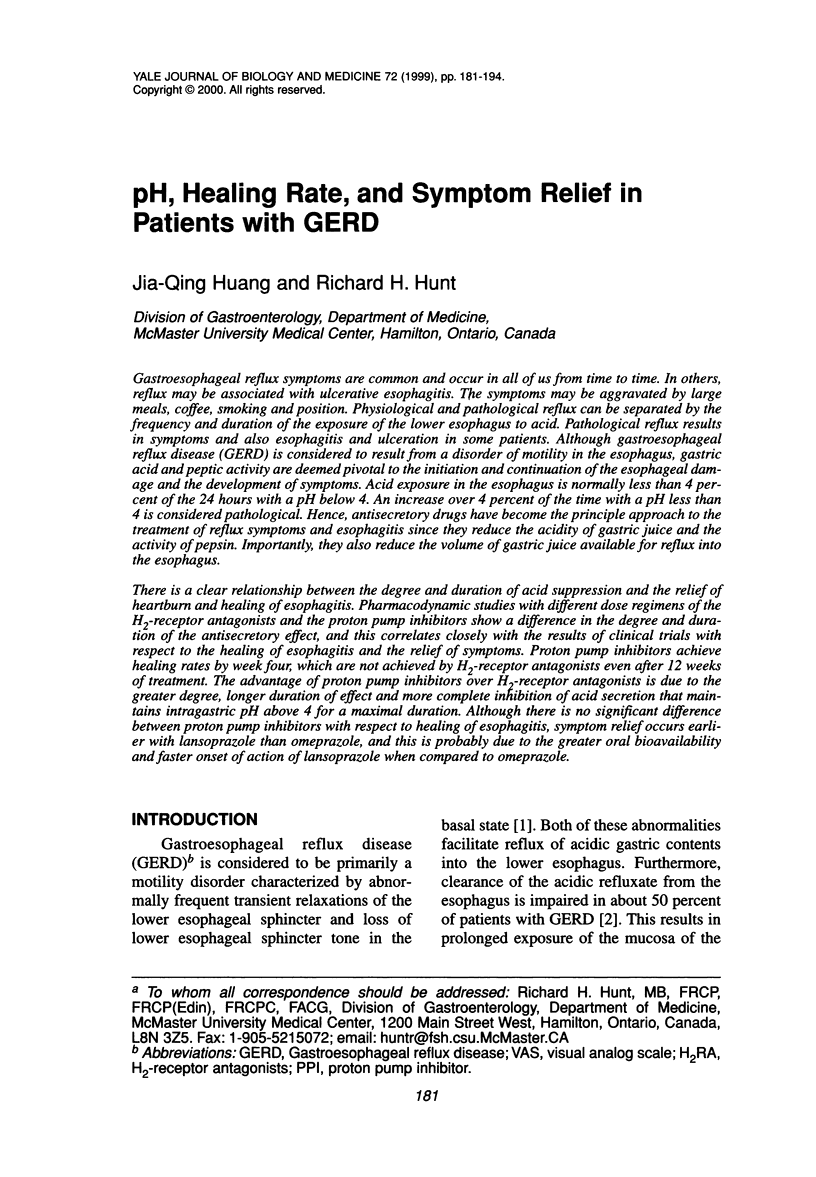
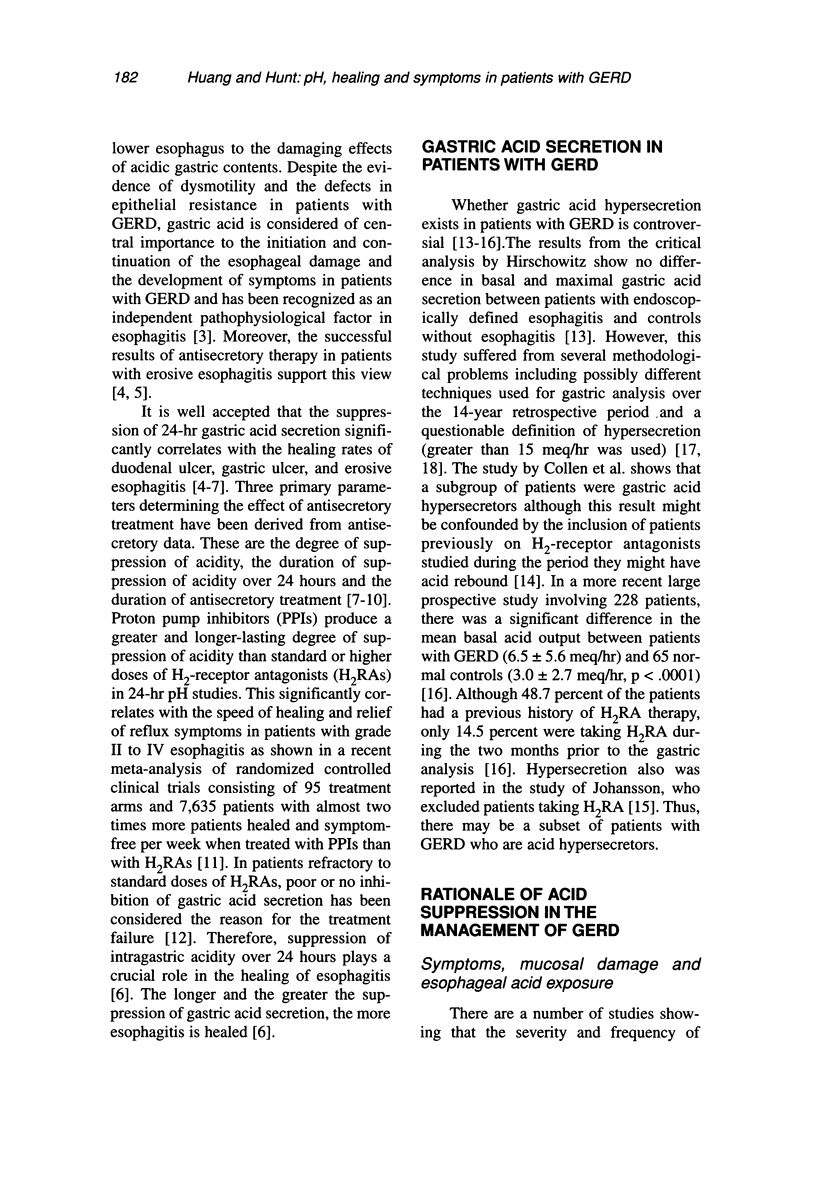
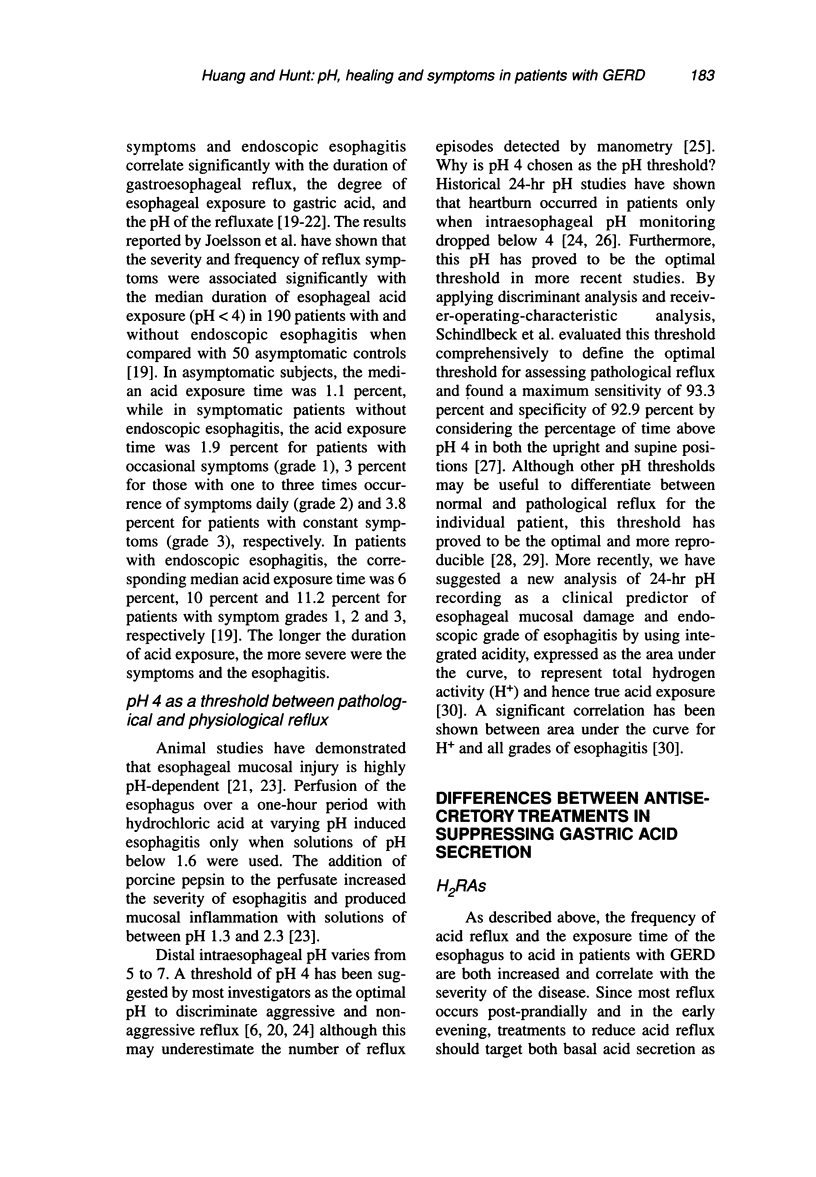
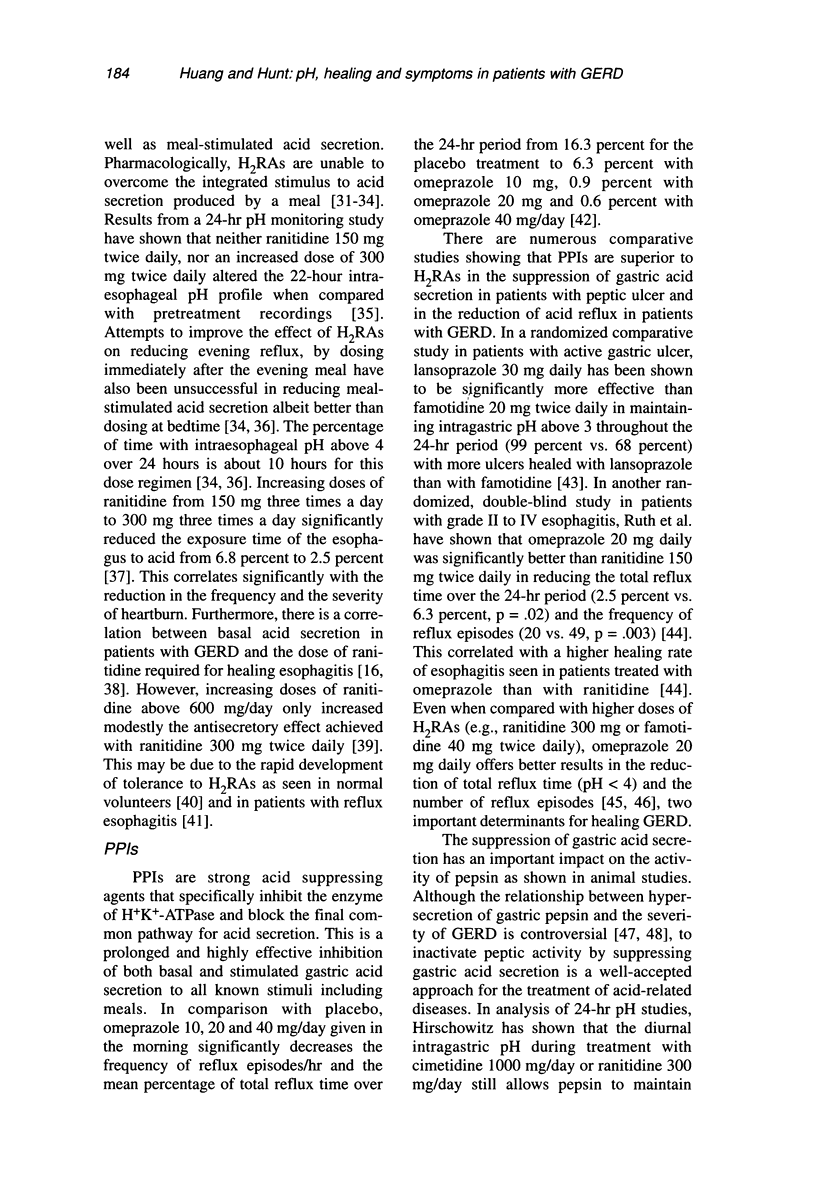
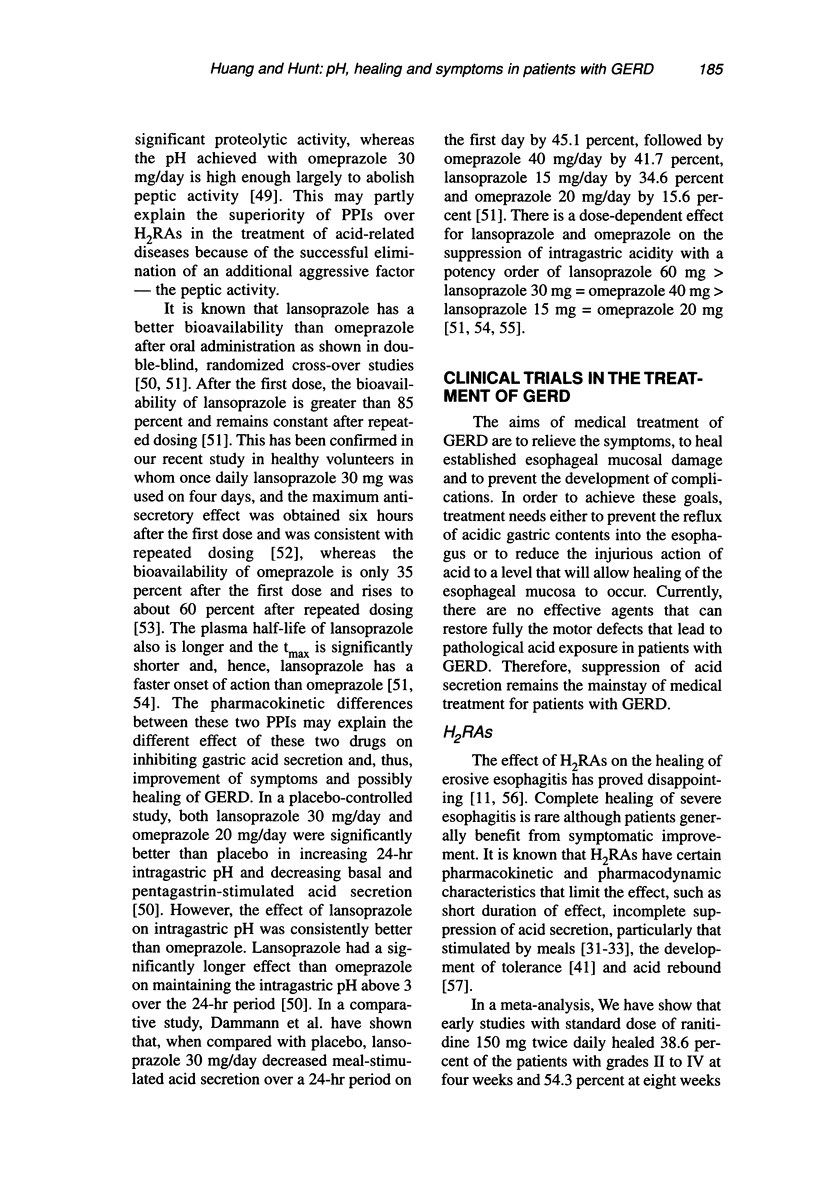
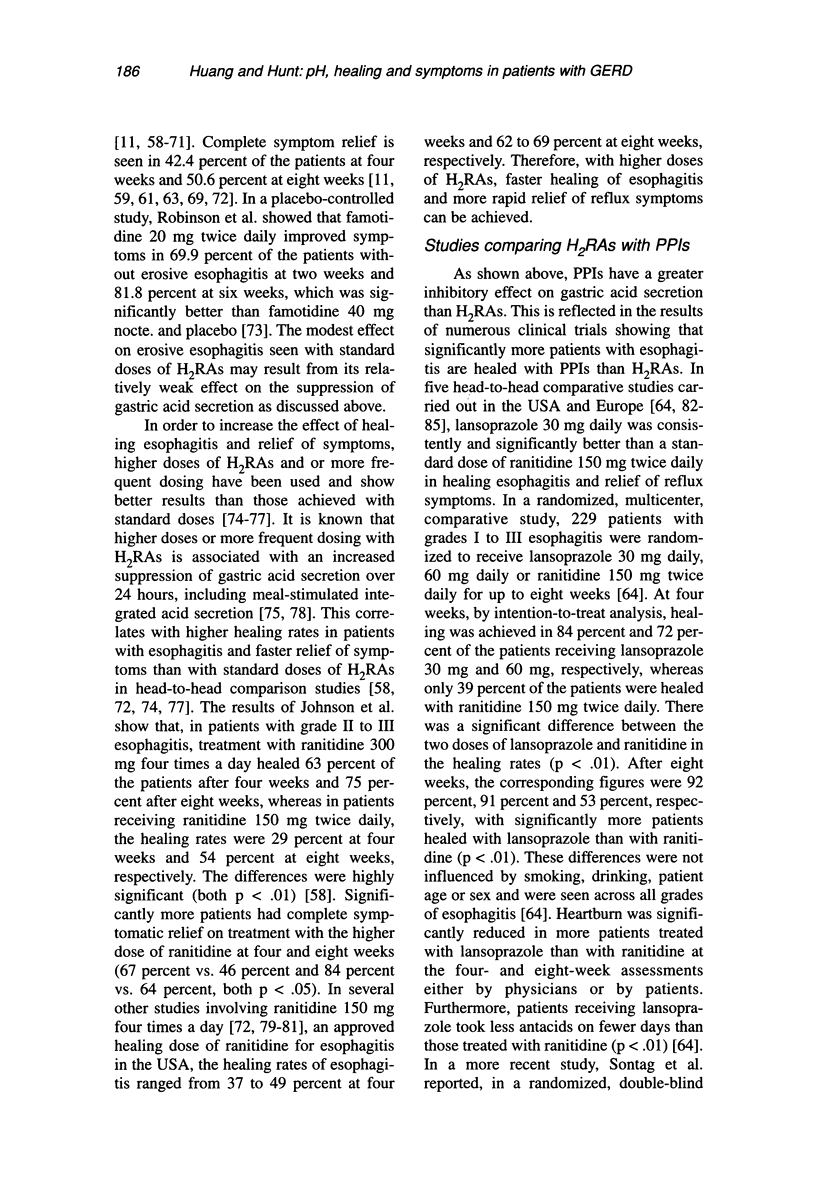
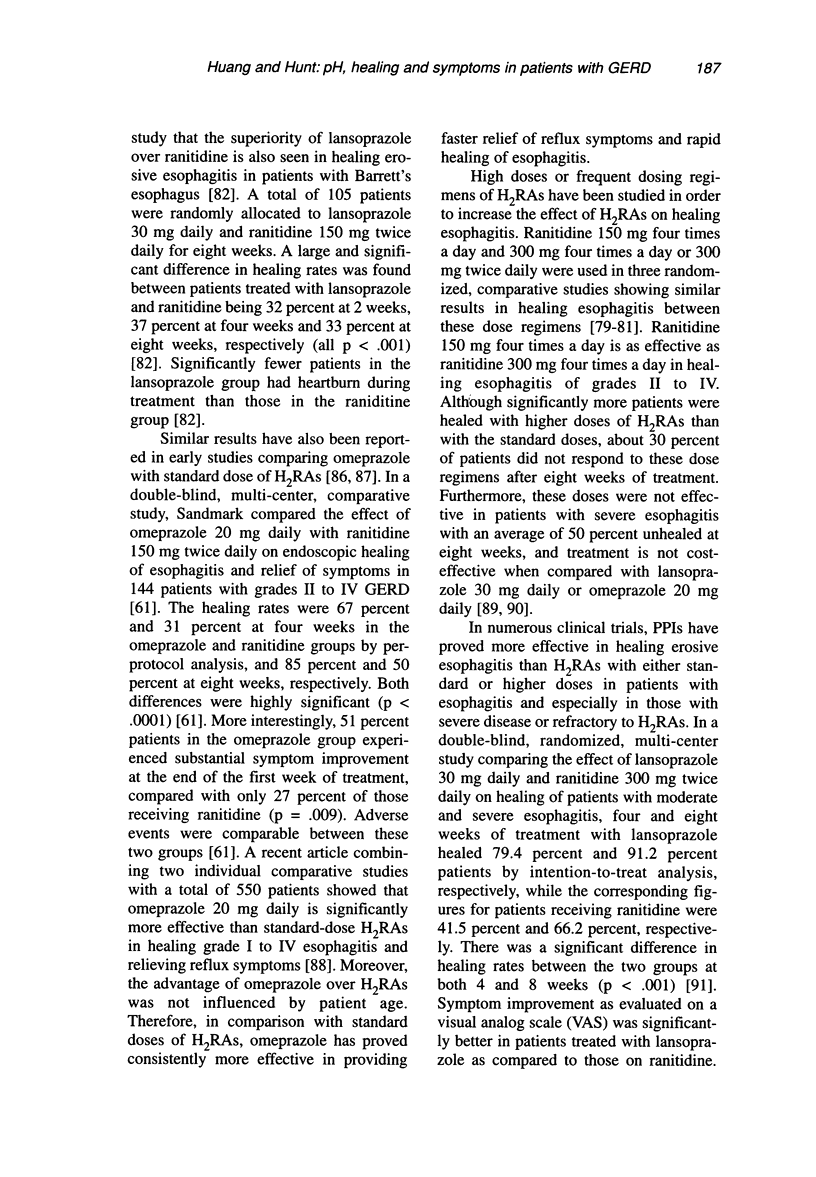
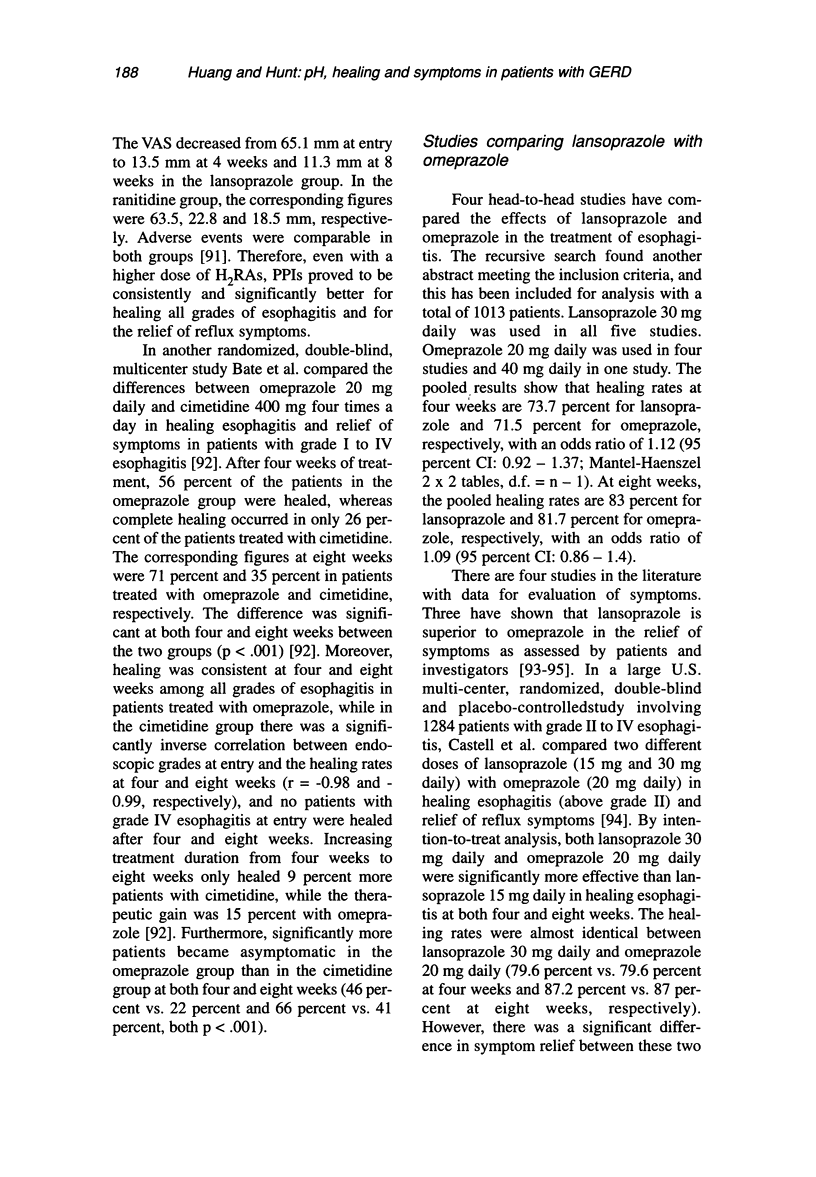
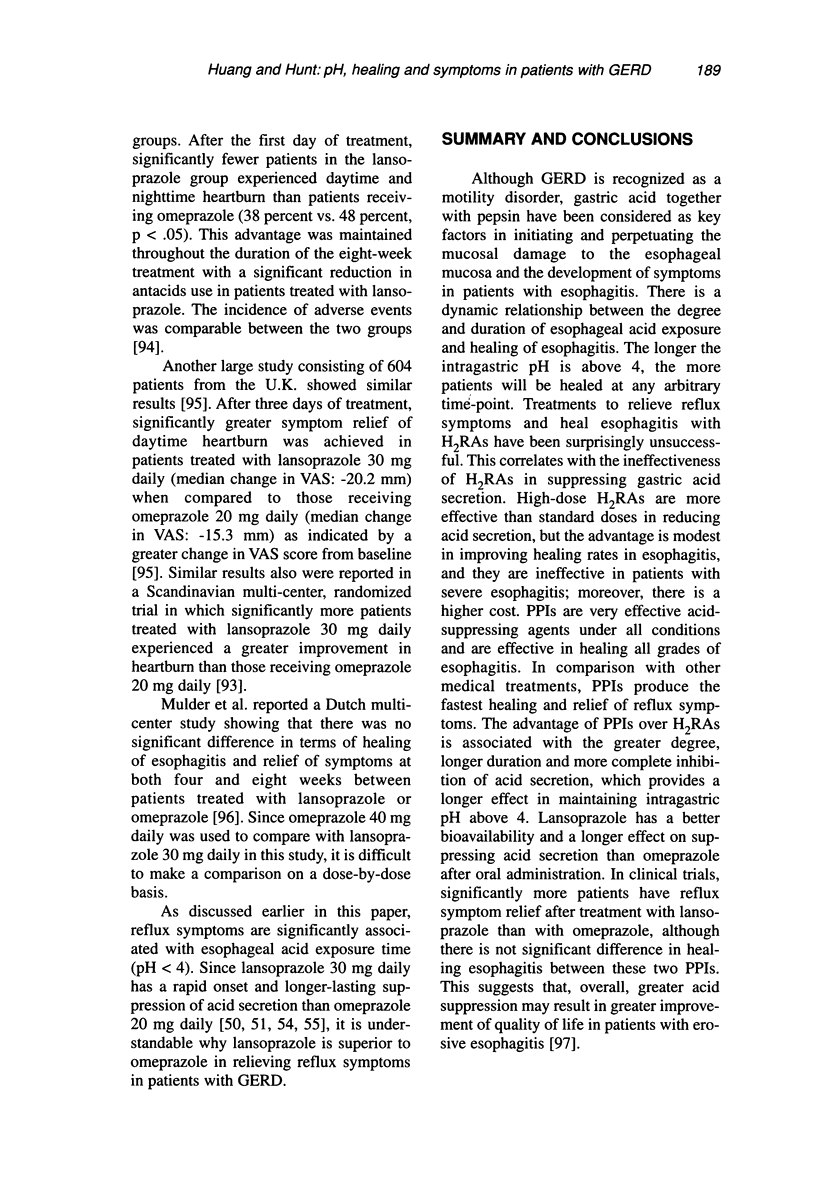

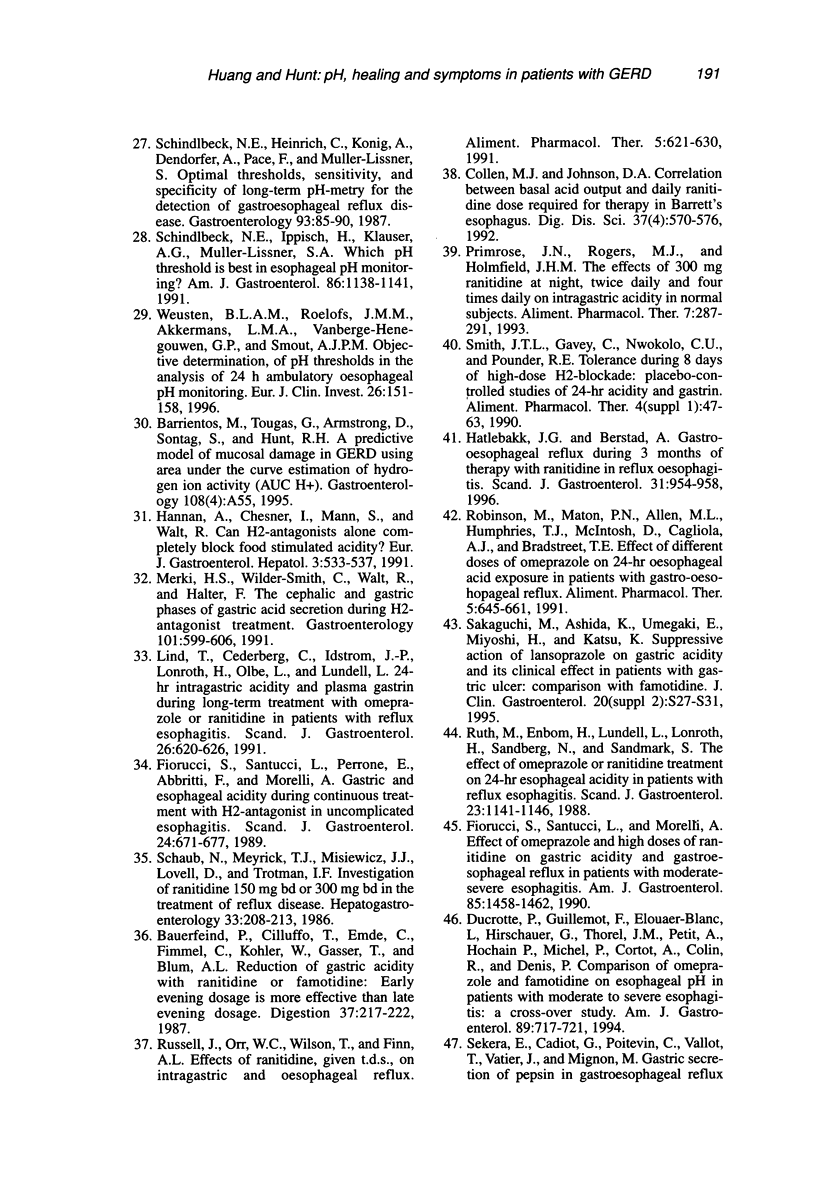
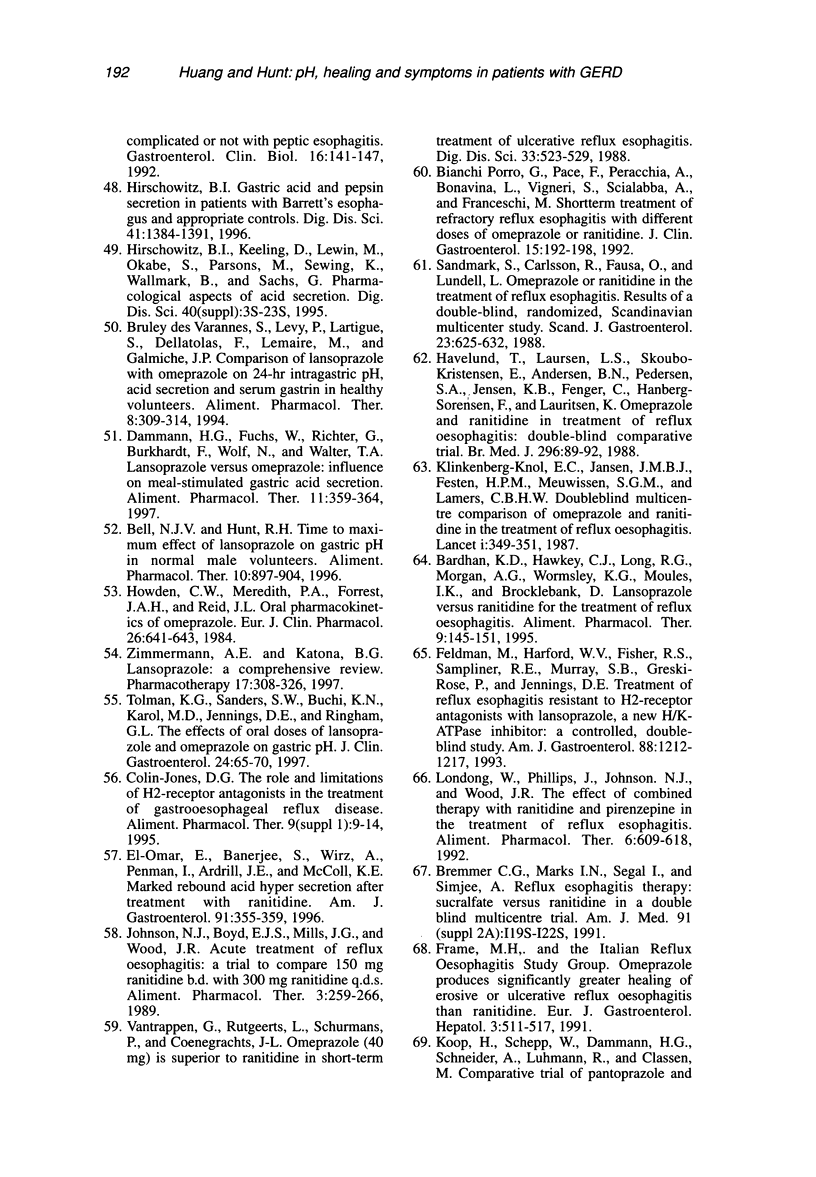
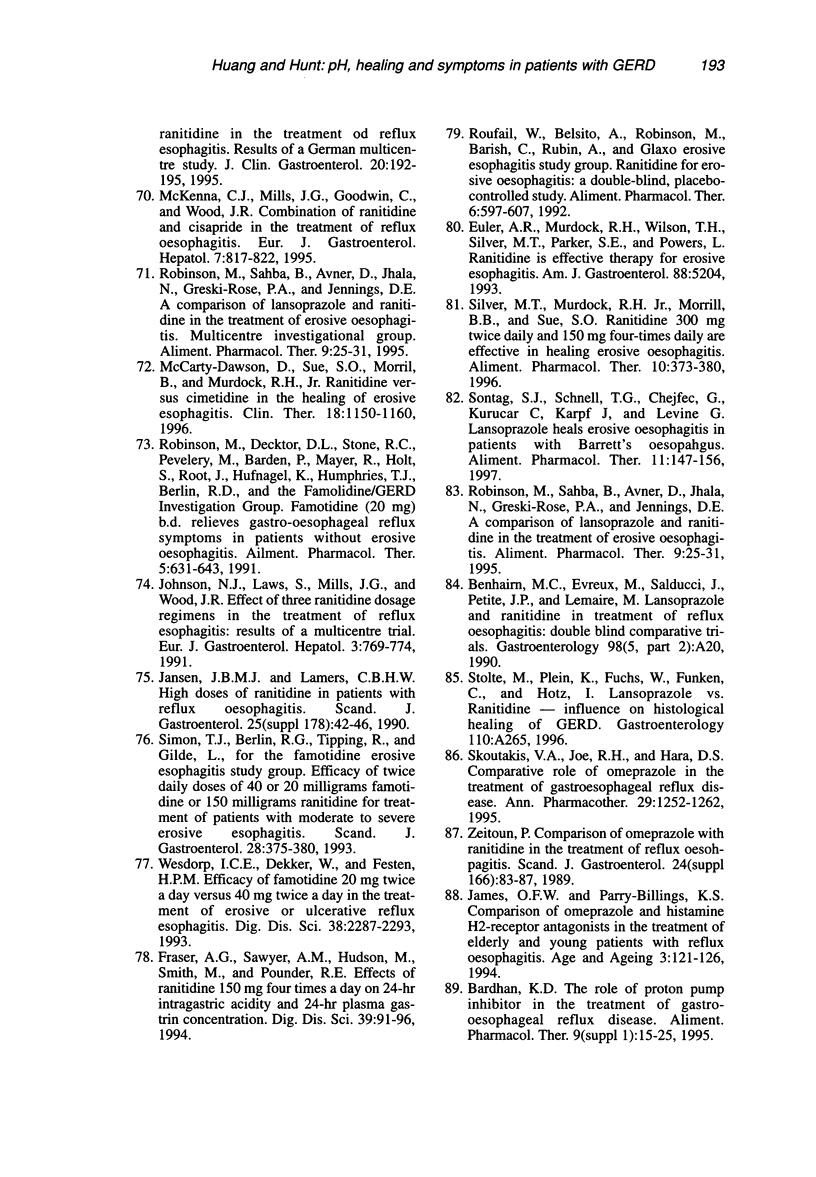
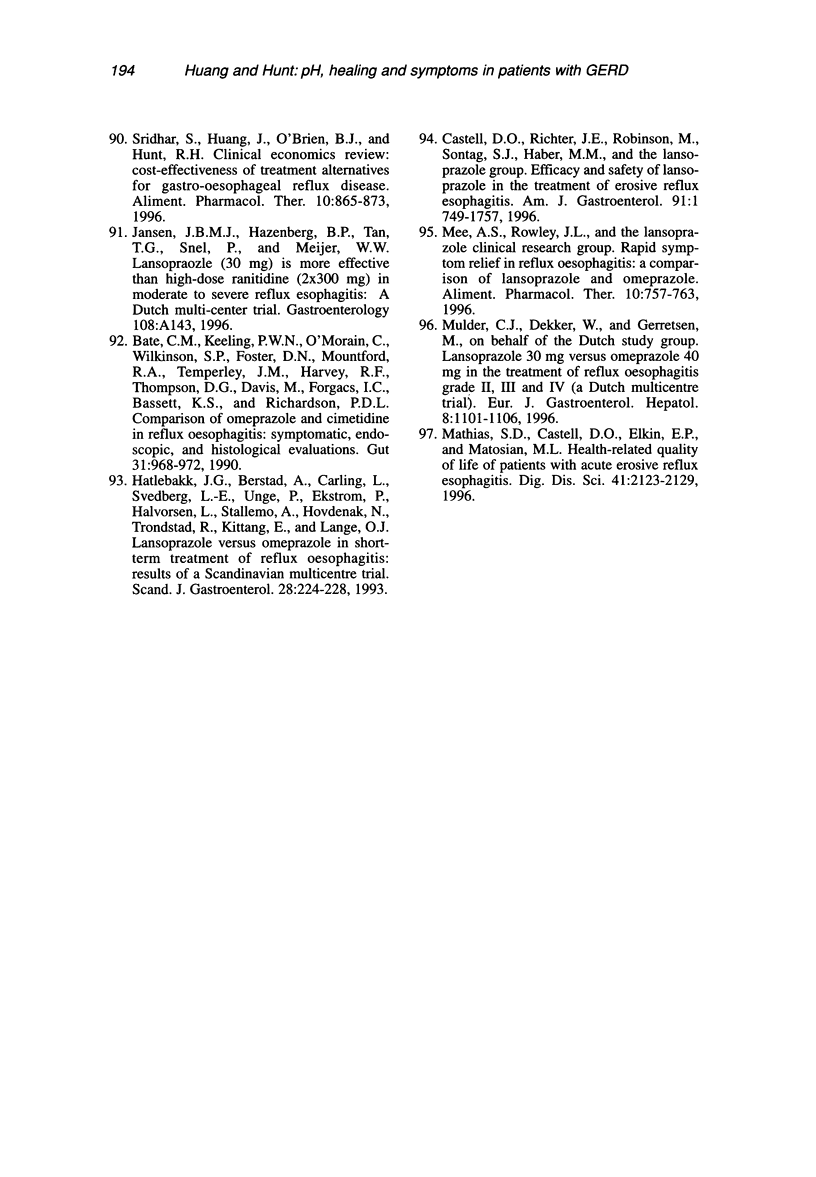
Selected References
These references are in PubMed. This may not be the complete list of references from this article.
- Bardhan K. D., Hawkey C. J., Long R. G., Morgan A. G., Wormsley K. G., Moules I. K., Brocklebank D. Lansoprazole versus ranitidine for the treatment of reflux oesophagitis. UK Lansoprazole Clinical Research Group. Aliment Pharmacol Ther. 1995 Apr;9(2):145–151. doi: 10.1111/j.1365-2036.1995.tb00363.x. [DOI] [PubMed] [Google Scholar]
- Bardhan K. D. The role of proton pump inhibitors in the treatment of gastro-oesophageal reflux disease. Aliment Pharmacol Ther. 1995;9 (Suppl 1):15–25. doi: 10.1111/j.1365-2036.1995.tb00779.x. [DOI] [PubMed] [Google Scholar]
- Bate C. M., Keeling P. W., O'Morain C., Wilkinson S. P., Foster D. N., Mountford R. A., Temperley J. M., Harvey R. F., Thompson D. G., Davis M. Comparison of omeprazole and cimetidine in reflux oesophagitis: symptomatic, endoscopic, and histological evaluations. Gut. 1990 Sep;31(9):968–972. doi: 10.1136/gut.31.9.968. [DOI] [PMC free article] [PubMed] [Google Scholar]
- Bauerfeind P., Cilluffo T., Emde C., Fimmel C., Kohler W., Gasser T., Blum A. L. Reduction of gastric acidity with ranitidine or famotidine: early evening dosage is more effective than late evening dosage. Digestion. 1987;37(4):217–222. doi: 10.1159/000199504. [DOI] [PubMed] [Google Scholar]
- Bell N. J., Burget D., Howden C. W., Wilkinson J., Hunt R. H. Appropriate acid suppression for the management of gastro-oesophageal reflux disease. Digestion. 1992;51 (Suppl 1):59–67. doi: 10.1159/000200917. [DOI] [PubMed] [Google Scholar]
- Bell N. J., Hunt R. H. Time to maximum effect of lansoprazole on gastric pH in normal male volunteers. Aliment Pharmacol Ther. 1996 Dec;10(6):897–904. doi: 10.1046/j.1365-2036.1996.103242000.x. [DOI] [PubMed] [Google Scholar]
- Bianchi Porro G., Pace F., Peracchia A., Bonavina L., Vigneri S., Scialabba A., Franceschi M. Short-term treatment of refractory reflux esophagitis with different doses of omeprazole or ranitidine. J Clin Gastroenterol. 1992 Oct;15(3):192–198. doi: 10.1097/00004836-199210000-00004. [DOI] [PubMed] [Google Scholar]
- Bremner C. G., Marks I. N., Segal I., Simjee A. Reflux esophagitis therapy: sucralfate versus ranitidine in a double blind multicenter trial. Am J Med. 1991 Aug 8;91(2A):119S–122S. doi: 10.1016/0002-9343(91)90462-7. [DOI] [PubMed] [Google Scholar]
- Bruley des Varannes S., Levy P., Lartigue S., Dellatolas F., Lemaire M., Galmiche J. P. Comparison of lansoprazole with omeprazole on 24-hour intragastric pH, acid secretion and serum gastrin in healthy volunteers. Aliment Pharmacol Ther. 1994 Jun;8(3):309–314. doi: 10.1111/j.1365-2036.1994.tb00293.x. [DOI] [PubMed] [Google Scholar]
- Burget D. W., Chiverton S. G., Hunt R. H. Is there an optimal degree of acid suppression for healing of duodenal ulcers? A model of the relationship between ulcer healing and acid suppression. Gastroenterology. 1990 Aug;99(2):345–351. doi: 10.1016/0016-5085(90)91015-x. [DOI] [PubMed] [Google Scholar]
- Cadiot G., Bruhat A., Rigaud D., Coste T., Vuagnat A., Benyedder Y., Vallot T., Le Guludec D., Mignon M. Multivariate analysis of pathophysiological factors in reflux oesophagitis. Gut. 1997 Feb;40(2):167–174. doi: 10.1136/gut.40.2.167. [DOI] [PMC free article] [PubMed] [Google Scholar]
- Castell D. O., Richter J. E., Robinson M., Sontag S. J., Haber M. M. Efficacy and safety of lansoprazole in the treatment of erosive reflux esophagitis. The Lansoprazole Group. Am J Gastroenterol. 1996 Sep;91(9):1749–1757. [PubMed] [Google Scholar]
- Chiba N., De Gara C. J., Wilkinson J. M., Hunt R. H. Speed of healing and symptom relief in grade II to IV gastroesophageal reflux disease: a meta-analysis. Gastroenterology. 1997 Jun;112(6):1798–1810. doi: 10.1053/gast.1997.v112.pm9178669. [DOI] [PubMed] [Google Scholar]
- Colin-Jones D. G. The role and limitations of H2-receptor antagonists in the treatment of gastro-oesophageal reflux disease. Aliment Pharmacol Ther. 1995;9 (Suppl 1):9–14. doi: 10.1111/j.1365-2036.1995.tb00778.x. [DOI] [PubMed] [Google Scholar]
- Collen M. J., Johnson D. A. Correlation between basal acid output and daily ranitidine dose required for therapy in Barrett's esophagus. Dig Dis Sci. 1992 Apr;37(4):570–576. doi: 10.1007/BF01307581. [DOI] [PubMed] [Google Scholar]
- Collen M. J., Johnson D. A., Sheridan M. J. Basal acid output and gastric acid hypersecretion in gastroesophageal reflux disease. Correlation with ranitidine therapy. Dig Dis Sci. 1994 Feb;39(2):410–417. doi: 10.1007/BF02090216. [DOI] [PubMed] [Google Scholar]
- Collen M. J., Johnson D. A., Sheridan M. J. Basal acid output in gastroesophageal reflux disease. Gastroenterology. 1992 Jun;102(6):2182–2183. doi: 10.1016/0016-5085(92)90366-7. [DOI] [PubMed] [Google Scholar]
- Collen M. J., Lewis J. H., Benjamin S. B. Gastric acid hypersecretion in refractory gastroesophageal reflux disease. Gastroenterology. 1990 Mar;98(3):654–661. doi: 10.1016/0016-5085(90)90285-9. [DOI] [PubMed] [Google Scholar]
- Collen M. J., Sheridan M. J. Definition for idiopathic gastric acid hypersecretion. A statistical and functional evaluation. Dig Dis Sci. 1991 Oct;36(10):1371–1376. doi: 10.1007/BF01296801. [DOI] [PubMed] [Google Scholar]
- Dammann H. G., Fuchs W., Richter G., Burkhardt F., Wolf N., Walter T. A. Lansoprazole versus omeprazole: influence on meal-stimulated gastric acid secretion. Aliment Pharmacol Ther. 1997 Apr;11(2):359–364. doi: 10.1046/j.1365-2036.1997.157332000.x. [DOI] [PubMed] [Google Scholar]
- Dent J., Holloway R. H., Toouli J., Dodds W. J. Mechanisms of lower oesophageal sphincter incompetence in patients with symptomatic gastrooesophageal reflux. Gut. 1988 Aug;29(8):1020–1028. doi: 10.1136/gut.29.8.1020. [DOI] [PMC free article] [PubMed] [Google Scholar]
- Ducrotté P., Guillemot F., Elouaer-Blanc L., Hirschauer C., Thorel J. M., Petit A., Hochain P., Michel P., Cortot A., Colin R. Comparison of omeprazole and famotidine on esophageal pH in patients with moderate to severe esophagitis: a cross-over study. Am J Gastroenterol. 1994 May;89(5):717–721. [PubMed] [Google Scholar]
- Feldman M., Harford W. V., Fisher R. S., Sampliner R. E., Murray S. B., Greski-Rose P. A., Jennings D. E. Treatment of reflux esophagitis resistant to H2-receptor antagonists with lansoprazole, a new H+/K(+)-ATPase inhibitor: a controlled, double-blind study. Lansoprazole Study Group. Am J Gastroenterol. 1993 Aug;88(8):1212–1217. [PubMed] [Google Scholar]
- Fiorucci S., Santucci L., Morelli A. Effect of omeprazole and high doses of ranitidine on gastric acidity and gastroesophageal reflux in patients with moderate-severe esophagitis. Am J Gastroenterol. 1990 Nov;85(11):1458–1462. [PubMed] [Google Scholar]
- Fiorucci S., Santucci L., Perrone E., Abbritti F., Morelli A. Gastric and esophageal acidity during continuous treatment with H2-antagonists in uncomplicated esophagitis. Scand J Gastroenterol. 1989 Aug;24(6):671–677. doi: 10.3109/00365528909093107. [DOI] [PubMed] [Google Scholar]
- Fraser A. G., Sawyerr A. M., Hudson M., Smith M., Pounder R. E. Effects of ranitidine 150 mg four times a day on 24-hour intragastric acidity and 24-hour plasma gastrin concentration. Dig Dis Sci. 1994 Jan;39(1):91–96. doi: 10.1007/BF02090066. [DOI] [PubMed] [Google Scholar]
- Goldberg H. I., Dodds W. J., Gee S., Montgomery C., Zboralske F. F. Role of acid and pepsin in acute experimental esophagitis. Gastroenterology. 1969 Feb;56(2):223–230. [PubMed] [Google Scholar]
- Hatlebakk J. G., Berstad A., Carling L., Svedberg L. E., Unge P., Ekström P., Halvorsen L., Stallemo A., Hovdenak N., Trondstad R. Lansoprazole versus omeprazole in short-term treatment of reflux oesophagitis. Results of a Scandinavian multicentre trial. Scand J Gastroenterol. 1993 Mar;28(3):224–228. doi: 10.3109/00365529309096076. [DOI] [PubMed] [Google Scholar]
- Hatlebakk J. G., Berstad A. Gastro-oesophageal reflux during 3 months of therapy with ranitidine in reflux oesophagitis. Scand J Gastroenterol. 1996 Oct;31(10):954–958. doi: 10.3109/00365529609003113. [DOI] [PubMed] [Google Scholar]
- Havelund T., Laursen L. S., Skoubo-Kristensen E., Andersen B. N., Pedersen S. A., Jensen K. B., Fenger C., Hanberg-Sørensen F., Lauritsen K. Omeprazole and ranitidine in treatment of reflux oesophagitis: double blind comparative trial. Br Med J (Clin Res Ed) 1988 Jan 9;296(6615):89–92. doi: 10.1136/bmj.296.6615.89. [DOI] [PMC free article] [PubMed] [Google Scholar]
- Helm J. F. Esophageal acid clearance. J Clin Gastroenterol. 1986;8 (Suppl 1):5–11. doi: 10.1097/00004836-198606001-00003. [DOI] [PubMed] [Google Scholar]
- Hirschowitz B. I. A critical analysis, with appropriate controls, of gastric acid and pepsin secretion in clinical esophagitis. Gastroenterology. 1991 Nov;101(5):1149–1158. doi: 10.1016/0016-5085(91)90062-p. [DOI] [PubMed] [Google Scholar]
- Hirschowitz B. I. Gastric acid and pepsin secretion in patients with Barrett's esophagus and appropriate controls. Dig Dis Sci. 1996 Jul;41(7):1384–1391. doi: 10.1007/BF02088563. [DOI] [PubMed] [Google Scholar]
- Hirschowitz B. I., Keeling D., Lewin M., Okabe S., Parsons M., Sewing K., Wallmark B., Sachs G. Pharmacological aspects of acid secretion. Dig Dis Sci. 1995 Feb;40(2 Suppl):3S–23S. doi: 10.1007/BF02214869. [DOI] [PubMed] [Google Scholar]
- Howden C. W., Jones D. B., Peace K. E., Burget D. W., Hunt R. H. The treatment of gastric ulcer with antisecretory drugs. Relationship of pharmacological effect to healing rates. Dig Dis Sci. 1988 May;33(5):619–624. doi: 10.1007/BF01798367. [DOI] [PubMed] [Google Scholar]
- Howden C. W., Meredith P. A., Forrest J. A., Reid J. L. Oral pharmacokinetics of omeprazole. Eur J Clin Pharmacol. 1984;26(5):641–643. doi: 10.1007/BF00543502. [DOI] [PubMed] [Google Scholar]
- Hunt R. H., Cederberg C., Dent J., Halter F., Howden C., Marks I. N., Rune S., Walt R. P. Optimizing acid suppression for treatment of acid-related diseases. Dig Dis Sci. 1995 Feb;40(2 Suppl):24S–49S. doi: 10.1007/BF02214870. [DOI] [PubMed] [Google Scholar]
- Hunt R. H. The relationship between the control of pH and healing and symptom relief in gastro-oesophageal reflux disease. Aliment Pharmacol Ther. 1995;9 (Suppl 1):3–7. doi: 10.1111/j.1365-2036.1995.tb00777.x. [DOI] [PubMed] [Google Scholar]
- James O. F., Parry-Billings K. S. Comparison of omeprazole and histamine H2-receptor antagonists in the treatment of elderly and young patients with reflux oesophagitis. Age Ageing. 1994 Mar;23(2):121–126. doi: 10.1093/ageing/23.2.121. [DOI] [PubMed] [Google Scholar]
- Jansen J. B., Lamers C. B. High doses of ranitidine in patients with reflux oesophagitis. Scand J Gastroenterol Suppl. 1990;178:42–46. doi: 10.3109/00365529009093149. [DOI] [PubMed] [Google Scholar]
- Joelsson B., Johnsson F. Heartburn--the acid test. Gut. 1989 Nov;30(11):1523–1525. doi: 10.1136/gut.30.11.1523. [DOI] [PMC free article] [PubMed] [Google Scholar]
- Johansson K. E., Ask P., Boeryd B., Fransson S. G., Tibbling L. Oesophagitis, signs of reflux, and gastric acid secretion in patients with symptoms of gastro-oesophageal reflux disease. Scand J Gastroenterol. 1986 Sep;21(7):837–847. doi: 10.3109/00365528609011128. [DOI] [PubMed] [Google Scholar]
- Johnson L. F., Demeester T. R. Twenty-four-hour pH monitoring of the distal esophagus. A quantitative measure of gastroesophageal reflux. Am J Gastroenterol. 1974 Oct;62(4):325–332. [PubMed] [Google Scholar]
- Johnson N. J., Boyd E. J., Mills J. G., Wood J. R. Acute treatment of reflux oesophagitis: a multicentre trial to compare 150 mg ranitidine b.d. with 300 mg ranitidine q.d.s. Aliment Pharmacol Ther. 1989 Jun;3(3):259–266. doi: 10.1111/j.1365-2036.1989.tb00212.x. [DOI] [PubMed] [Google Scholar]
- Jones D. B., Howden C. W., Burget D. W., Kerr G. D., Hunt R. H. Acid suppression in duodenal ulcer: a meta-analysis to define optimal dosing with antisecretory drugs. Gut. 1987 Sep;28(9):1120–1127. doi: 10.1136/gut.28.9.1120. [DOI] [PMC free article] [PubMed] [Google Scholar]
- Klinkenberg-Knol E. C., Jansen J. M., Festen H. P., Meuwissen S. G., Lamers C. B. Double-blind multicentre comparison of omeprazole and ranitidine in the treatment of reflux oesophagitis. Lancet. 1987 Feb 14;1(8529):349–351. doi: 10.1016/s0140-6736(87)91726-0. [DOI] [PubMed] [Google Scholar]
- Koop H., Schepp W., Dammann H. G., Schneider A., Lühmann R., Classen M. Comparative trial of pantoprazole and ranitidine in the treatment of reflux esophagitis. Results of a German multicenter study. J Clin Gastroenterol. 1995 Apr;20(3):192–195. doi: 10.1097/00004836-199504000-00005. [DOI] [PubMed] [Google Scholar]
- Lind T., Cederberg C., Idström J. P., Lönroth H., Olbe L., Lundell L. 24-hour intragastric acidity and plasma gastrin during long-term treatment with omeprazole or ranitidine in patients with reflux esophagitis. Scand J Gastroenterol. 1991 Jun;26(6):620–626. doi: 10.3109/00365529109043636. [DOI] [PubMed] [Google Scholar]
- Londong W., Phillips J., Johnson N. J., Wood J. R. The effect of combined therapy with ranitidine and pirenzepine in the treatment of reflux oesophagitis. Aliment Pharmacol Ther. 1992 Oct;6(5):609–618. doi: 10.1111/j.1365-2036.1992.tb00575.x. [DOI] [PubMed] [Google Scholar]
- Mathias S. D., Castell D. O., Elkin E. P., Matosian M. L. Health-related quality of life of patients with acute erosive reflux esophagitis. Dig Dis Sci. 1996 Nov;41(11):2123–2129. doi: 10.1007/BF02071390. [DOI] [PubMed] [Google Scholar]
- Matikainen M. Gastric acid secretion, oesophageal acid reflux, and oesophagitis in patients with symptomatic gastro-oesophageal reflux. Scand J Gastroenterol. 1981;16(8):1043–1048. doi: 10.3109/00365528109181026. [DOI] [PubMed] [Google Scholar]
- McCarty-Dawson D., Sue S. O., Morrill B., Murdock R. H., Jr Ranitidine versus cimetidine in the healing of erosive esophagitis. Clin Ther. 1996 Nov-Dec;18(6):1150–1160. doi: 10.1016/s0149-2918(96)80069-5. [DOI] [PubMed] [Google Scholar]
- McKenna C. J., Mills J. G., Goodwin C., Wood J. R. Combination of ranitidine and cisapride in the treatment of reflux oesophagitis. Eur J Gastroenterol Hepatol. 1995 Sep;7(9):817–822. [PubMed] [Google Scholar]
- Mee A. S., Rowley J. L. Rapid symptom relief in reflux oesophagitis: a comparison of lansoprazole and omeprazole. Aliment Pharmacol Ther. 1996 Oct;10(5):757–763. doi: 10.1046/j.1365-2036.1996.56198000.x. [DOI] [PubMed] [Google Scholar]
- Merki H. S., Wilder-Smith C. H., Walt R. P., Halter F. The cephalic and gastric phases of gastric secretion during H2-antagonist treatment. Gastroenterology. 1991 Sep;101(3):599–606. doi: 10.1016/0016-5085(91)90515-m. [DOI] [PubMed] [Google Scholar]
- Mulder C. J., Dekker W., Gerretsen M. Lansoprazole 30 mg versus omeprazole 40 mg in the treatment of reflux oesophagitis grade II, III and IVa (a Dutch multicentre trial). Dutch Study Group. Eur J Gastroenterol Hepatol. 1996 Nov;8(11):1101–1106. doi: 10.1097/00042737-199611000-00013. [DOI] [PubMed] [Google Scholar]
- Primrose J. N., Rogers M. J., Holmfield J. H. The effects of 300 mg ranitidine at night, twice daily and four times daily on intragastric acidity in normal subjects. Aliment Pharmacol Ther. 1993 Jun;7(3):287–291. doi: 10.1111/j.1365-2036.1993.tb00100.x. [DOI] [PubMed] [Google Scholar]
- Robinsen M., Decktor D. L., Stone R. C., Pevelery M., Barden P., Moyer R., Holt S., Root J., Hufnagel K., Humphries T. J. Famotidine (20 mg) b.d. relieves gastrooesophageal reflux symptoms in patients without erosive oesophagitis. Famotidine/GERD Investigation Group. Aliment Pharmacol Ther. 1991 Dec;5(6):631–643. doi: 10.1111/j.1365-2036.1991.tb00531.x. [DOI] [PubMed] [Google Scholar]
- Robinson M., Maton P. N., Allen M. L., Humphries T. J., McIntosh D., Cagliola A. J., Bradstreet T. E. Effect of different doses of omeprazole on 24-hour oesophageal acid exposure in patients with gastro-oesophageal reflux. Aliment Pharmacol Ther. 1991 Dec;5(6):645–651. doi: 10.1111/j.1365-2036.1991.tb00532.x. [DOI] [PubMed] [Google Scholar]
- Robinson M., Sahba B., Avner D., Jhala N., Greski-Rose P. A., Jennings D. E. A comparison of lansoprazole and ranitidine in the treatment of erosive oesophagitis. Multicentre Investigational Group. Aliment Pharmacol Ther. 1995 Feb;9(1):25–31. doi: 10.1111/j.1365-2036.1995.tb00347.x. [DOI] [PubMed] [Google Scholar]
- Robinson M., Sahba B., Avner D., Jhala N., Greski-Rose P. A., Jennings D. E. A comparison of lansoprazole and ranitidine in the treatment of erosive oesophagitis. Multicentre Investigational Group. Aliment Pharmacol Ther. 1995 Feb;9(1):25–31. doi: 10.1111/j.1365-2036.1995.tb00347.x. [DOI] [PubMed] [Google Scholar]
- Roufail W., Belsito A., Robinson M., Barish C., Rubin A. Ranitidine for erosive oesophagitis: a double-blind, placebo-controlled study. Glaxo Erosive Esophagitis Study Group. Aliment Pharmacol Ther. 1992 Oct;6(5):597–607. doi: 10.1111/j.1365-2036.1992.tb00574.x. [DOI] [PubMed] [Google Scholar]
- Russell J., Orr W. C., Wilson T., Finn A. L. Effects of ranitidine, given t.d.s., on intragastric and oesophageal pH in patients with gastrooesophageal reflux. Aliment Pharmacol Ther. 1991 Dec;5(6):621–630. doi: 10.1111/j.1365-2036.1991.tb00530.x. [DOI] [PubMed] [Google Scholar]
- Ruth M., Enbom H., Lundell L., Lönroth H., Sandberg N., Sandmark S. The effect of omeprazole or ranitidine treatment on 24-hour esophageal acidity in patients with reflux esophagitis. Scand J Gastroenterol. 1988 Nov;23(9):1141–1146. doi: 10.3109/00365528809090182. [DOI] [PubMed] [Google Scholar]
- Sakaguchi M., Ashida K., Umegaki E., Miyoshi H., Katsu K. Suppressive action of lansoprazole on gastric acidity and its clinical effect in patients with gastric ulcers: comparison with famotidine. J Clin Gastroenterol. 1995;20 (Suppl 2):S27–S31. doi: 10.1097/00004836-199506002-00008. [DOI] [PubMed] [Google Scholar]
- Sandmark S., Carlsson R., Fausa O., Lundell L. Omeprazole or ranitidine in the treatment of reflux esophagitis. Results of a double-blind, randomized, Scandinavian multicenter study. Scand J Gastroenterol. 1988 Jun;23(5):625–632. doi: 10.3109/00365528809093923. [DOI] [PubMed] [Google Scholar]
- Schaub N., Meyrick Thomas J., Misiewicz J. J., Lovell D., Trotman I. F. Investigation of ranitidine 150 mg bd or 300 mg bd in the treatment of reflux disease. Hepatogastroenterology. 1986 Oct;33(5):208–213. [PubMed] [Google Scholar]
- Schindlbeck N. E., Heinrich C., König A., Dendorfer A., Pace F., Müller-Lissner S. A. Optimal thresholds, sensitivity, and specificity of long-term pH-metry for the detection of gastroesophageal reflux disease. Gastroenterology. 1987 Jul;93(1):85–90. doi: 10.1016/0016-5085(87)90318-0. [DOI] [PubMed] [Google Scholar]
- Schindlbeck N. E., Ippisch H., Klauser A. G., Müller-Lissner S. A. Which pH threshold is best in esophageal pH monitoring? Am J Gastroenterol. 1991 Sep;86(9):1138–1141. [PubMed] [Google Scholar]
- Sekera E., Cadiot G., Poitevin C., Vallot T., Vatier J., Mignon M. Sécrétion gastrique de pepsine dans le reflux gastro-oesophagien compliqué ou non d'oesophagite peptique. Gastroenterol Clin Biol. 1992;16(2):141–147. [PubMed] [Google Scholar]
- Silver M. T., Murdock R. H., Jr, Morrill B. B., Sue S. O. Ranitidine 300 mg twice daily and 150 mg four-times daily are effective in healing erosive oesophagitis. Aliment Pharmacol Ther. 1996 Jun;10(3):373–380. doi: 10.1111/j.0953-0673.1996.00373.x. [DOI] [PubMed] [Google Scholar]
- Simon T. J., Berlin R. G., Tipping R., Gilde L. Efficacy of twice daily doses of 40 or 20 milligrams famotidine or 150 milligrams ranitidine for treatment of patients with moderate to severe erosive esophagitis. Famotidine Erosive Esophagitis Study Group. Scand J Gastroenterol. 1993 May;28(5):375–380. doi: 10.3109/00365529309098235. [DOI] [PubMed] [Google Scholar]
- Skoutakis V. A., Joe R. H., Hara D. S. Comparative role of omeprazole in the treatment of gastroesophageal reflux disease. Ann Pharmacother. 1995 Dec;29(12):1252–1262. doi: 10.1177/106002809502901212. [DOI] [PubMed] [Google Scholar]
- Smith J. L., Opekun A. R., Larkai E., Graham D. Y. Sensitivity of the esophageal mucosa to pH in gastroesophageal reflux disease. Gastroenterology. 1989 Mar;96(3):683–689. [PubMed] [Google Scholar]
- Smith J. T., Gavey C., Nwokolo C. U., Pounder R. E. Tolerance during 8 days of high-dose H2-blockade: placebo-controlled studies of 24-hour acidity and gastrin. Aliment Pharmacol Ther. 1990;4 (Suppl 1):47–63. [PubMed] [Google Scholar]
- Sontag S. J. Rolling review: gastro-oesophageal reflux disease. Aliment Pharmacol Ther. 1993 Jun;7(3):293–312. doi: 10.1111/j.1365-2036.1993.tb00101.x. [DOI] [PubMed] [Google Scholar]
- Sontag S. J., Schnell T. G., Chejfec G., Kurucar C., Karpf J., Levine G. Lansoprazole heals erosive reflux oesophagitis in patients with Barrett's oesophagus. Aliment Pharmacol Ther. 1997 Feb;11(1):147–156. doi: 10.1046/j.1365-2036.1997.114285000.x. [DOI] [PubMed] [Google Scholar]
- Sridhar S., Huang J., O'Brien B. J., Hunt R. H. Clinical economics review: cost-effectiveness of treatment alternatives for gastro-oesophageal reflux disease. Aliment Pharmacol Ther. 1996 Dec;10(6):865–873. doi: 10.1046/j.1365-2036.1996.72241000.x. [DOI] [PubMed] [Google Scholar]
- TUTTLE S. G., RUFIN F., BETTARELLO A. The physiology of heartburn. Ann Intern Med. 1961 Aug;55:292–300. doi: 10.7326/0003-4819-55-2-292. [DOI] [PubMed] [Google Scholar]
- Tolman K. G., Sanders S. W., Buchi K. N., Karol M. D., Jennings D. E., Ringham G. L. The effects of oral doses of lansoprazole and omeprazole on gastric pH. J Clin Gastroenterol. 1997 Mar;24(2):65–70. doi: 10.1097/00004836-199703000-00003. [DOI] [PubMed] [Google Scholar]
- Vantrappen G., Rutgeerts L., Schurmans P., Coenegrachts J. L. Omeprazole (40 mg) is superior to ranitidine in short-term treatment of ulcerative reflux esophagitis. Dig Dis Sci. 1988 May;33(5):523–529. doi: 10.1007/BF01798351. [DOI] [PubMed] [Google Scholar]
- Wesdorp I. C., Dekker W., Festen H. P. Efficacy of famotidine 20 mg twice a day versus 40 mg twice a day in the treatment of erosive or ulcerative reflux esophagitis. Dig Dis Sci. 1993 Dec;38(12):2287–2293. doi: 10.1007/BF01299910. [DOI] [PubMed] [Google Scholar]
- Weusten B. L., Roelofs J. M., Akkermans L. M., Vanberge-Henegouwen G. P., Smout A. J. Objective determination of pH thresholds in the analysis of 24 h ambulatory oesophageal pH monitoring. Eur J Clin Invest. 1996 Feb;26(2):151–158. doi: 10.1046/j.1365-2362.1996.104249.x. [DOI] [PubMed] [Google Scholar]
- Wyman J. B., Dent J., Holloway R. H. Changes in oesophageal pH associated with gastro-oesophageal reflux. Are traditional criteria sensitive for detection of reflux? Scand J Gastroenterol. 1993 Sep;28(9):827–832. doi: 10.3109/00365529309104017. [DOI] [PubMed] [Google Scholar]
- Zaninotto G., Di Mario F., Costantini M., Baffa R., Germanà B., Dal Santo P. L., Rugge M., Bolzan M., Naccarato R., Ancona E. Oesophagitis and pH of refluxate: an experimental and clinical study. Br J Surg. 1992 Feb;79(2):161–164. doi: 10.1002/bjs.1800790222. [DOI] [PubMed] [Google Scholar]
- Zeitoun P. Comparison of omeprazole with ranitidine in the treatment of reflux oesophagitis. Scand J Gastroenterol Suppl. 1989;166:83–94. doi: 10.3109/00365528909091250. [DOI] [PubMed] [Google Scholar]
- Zimmermann A. E., Katona B. G. Lansoprazole: a comprehensive review. Pharmacotherapy. 1997 Mar-Apr;17(2):308–326. [PubMed] [Google Scholar]
- el-Omar E., Banerjee S., Wirz A., Penman I., Ardill J. E., McColl K. E. Marked rebound acid hypersecretion after treatment with ranitidine. Am J Gastroenterol. 1996 Feb;91(2):355–359. [PubMed] [Google Scholar]


